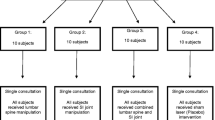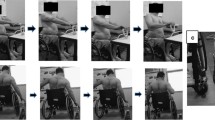Abstract
The aim of this study was to investigate the effects of chiropractic high velocity low amplitude (HVLA) sacroiliac and lumbosacral manipulation on the sprint, jump racing and jumping performance of amateur soccer players with asymptomatic dysfunction of the sacroiliac and lumbosacral joints. The 20‑m sprint, 20‑m jump racing and horizontal jumping distance of the soccer players analyzed in this study were measured before and after the applications. Sprint and obstacle course racing time were measured by stopwatch and video recordings. In total, 30 patients were included in the study. The participants were divided into 2 groups each with 15 members and were randomly selected. A sham manipulation was applied to the control group and chiropractic HVLA lumbosacral and sacroiliac manipulation was applied to the experimental group. The 20‑m sprint time of the control group decreased from 3.49 s to 3.46 s. In the experimental group the 20‑m sprint time decreased from 3.44 s to 3.22 s. The sprint values of the experimental group were statistically significantly faster than the control group (p < 0.05). In the control group the 20‑m obstacle course time decreased from 3.87 s to 3.79 s. In the experimental group the 20‑m obstacle course racing time decreased from 3.75 to 3.60 s. There was no statistically significant difference between the two groups (p > 0.05). In the control group the horizontal jump distance increased from 266.93 cm to 268.80 cm. This score increased from 261.13 cm to 267.80 cm in the experimental group. Comparison of the horizontal jumping distance revealed that the experimental group had a statistically significant better performance than the control group (p < 0.05).
Zusammenfassung
Ziel dieser Studie war es, die Auswirkungen der chiropraktischen Iliosakral- und Lumbosakralmanipulation mit hoher Geschwindigkeit und niedriger Amplitude (HVLA) auf die Sprint‑, Sprungrenn- und Sprungleistung von Amateurfußballspielern mit asymptomatischer Dysfunktion der Iliosakral- und Lumbosakralgelenke zu untersuchen. Die in dieser Studie analysierten 20-m-Sprint, 20-m-Sprungrennen und die horizontale Sprungweite der Fußballspieler wurden vor und nach den Anwendungen gemessen. Die Zeiten der Sprint- und Sprungrennen wurden mittels Stoppuhr und Videoaufnahmen gemessen. Insgesamt wurden 30 Patienten in die Studie eingeschlossen. Die Teilnehmer wurden in 2 Gruppen mit je 15 Mitgliedern aufgeteilt und nach dem Zufallsprinzip ausgewählt. In der Kontrollgruppe wurde eine Scheinmanipulation und in der Versuchsgruppe eine chiropraktische lumbosakrale und sakroiliakale Manipulation mit „high velocity low amplitude“ (HVLA) angewendet. Die 20-m-Sprintzeit der Kontrollgruppe verringerte sich von 3,49 auf 3,46 s. In der Versuchsgruppe sank die 20-m-Sprintzeit von 3,44 auf 3,22 s. Die Sprintzeiten der Versuchsgruppe waren statistisch signifikant schneller als die der Kontrollgruppe (p<0,05). In der Kontrollgruppe sanken die 20-m-Hindernislaufzeiten von 3,87 auf 3,79 s. In der Experimentalgruppe sank der 20-m-Sprintwert von 3,75 auf 3,60 s. Es gab keinen statistisch signifikanten Unterschied zwischen den beiden Gruppen (p>0,05). In der Kontrollgruppe erhöhte sich die horizontale Sprungweite von 266,93 auf 268,80 cm. In der Versuchsgruppe stieg dieser Wert von 261,13 auf 267,80 cm. Der Vergleich der horizontalen Sprungwerte ergab, dass die Versuchsgruppe eine statistisch signifikant bessere Leistung als die Kontrollgruppe aufwies (p<0,05).








Similar content being viewed by others
References
Rahnama N, Lees A, Reilly T (2006) Electromyography of selected lower-limb muscles fatigued by exercise at the intensity of soccer match-play. J Electromyogr Kinesiol 16(3):257–263
Canüzmez AE, Acar MF, Özçaldıran B (2006) İç Üst Vuruşta Kullanılan Kas Grupları Peak Torq Güçlerinin Topa Vuruş Mesafesiyle Arasındaki İlişki. The 9th International Sports Sciences Congress, Congress proceedings. Muğla University, Muğla, pp 246–248
Hoff J (2005) Training and testing physical capacities for elite soccer players. J Sports Sci 23(6):573–582
di Prampero PE, Botter A, Osgnach C (2015) The energy cost of sprint running and the role of metabolic power in setting top performances. Eur J Appl Physiol 115(3):451–469
Hunter JP, Marshall RN, McNair PJ (2004) Interaction of step length and step rate during sprint running. Med Sci Sports Exerc 36(2):61–71
Schache AG, Blanch PD, Murphy AT (2000) Relation of anterior pelvic tilt during running to clinical and kinematic measures of hip extension. Br J Sports Med 34:279–283
Lauro A, Mouch B (1991) Chiropractic effects on athletic ability. Chiropractic 6:84–87
Valenzuela PL, Pancorbo S, Lucia A, Germain F (2019) Spinal manipulative therapy effects in autonomic regulation and exercise performance in recreational healthy athletes: a randomized controlled trial. Spine 44(9):609–614
Soleimanifar M, Karimi N, Arab AM (2017) Association between composites of selected motion palpation and pain provocation tests for sacroiliac joint disorders. J Bodyw Mov Ther 21(2):240–245
Laslett M, Aprill CN, McDonald B, Young SB, (2005) Diagnosis of Sacroiliac Joint Pain: Validity of individual provocation tests and composites of tests. Man Ther 10(3):207–218
Shambaugh P, Sclafani L, Fanselow D (1988) Reliability of the Derifield-Thompson test for leg length inequality, and use of the test to demonstrate cervical adjusting efficacy. J Manip Physiol Ther 11(5):396–399
Fuhr AW et al (2009) Activator Methods Chiropractic Technique, 2nd edn. Mosby-Elsevier, St. Louis
James RS, Navas CA, Herrel A (2007) How important are skeletal muscle mechanics in setting limits on jumping performance? J Exp Biol 210(Pt 6):923–933
Bishop D, Girard O, Mendez-Villanueva A (2011) Repeated-sprint ability—part II: recommendations for training. Sports Med 41(9):741–756
Sherrod CW, Casey G, Dubro RE, Johnson DF (2013) The modulation of upper extremity musculoskeletal disorders for a knowledge worker with chiropractic care and applied ergonomics: a case study. J Chiropr Med 12(1):45–54
Deutschmann KC, Jones AD, Korporaal CM (2015) A non-randomised experimental feasibility study into the immediate effect of three different spinal manipulative protocols on kicking speed performance in soccer players. Chiropr Man Therap 23(1):1
Ward J, Coats J, Koby B, Goehry D, Olson BS, Bodziony M (2014) Effect of lumbar spine manipulation on asymptomatic cyclist sprint performance and hip flexibility. J Chiropr Med 13:230–238
Ruhe A, Bos Tino, Herbert A (2012) Pain originating from the sacroiliac joint is a common non-traumatic musculoskeletal complaint in elite Inline-Speedskaters—an observational study. Chiropr Man Therap 20(2012):5
Sandell Jörgen, Palmgren PJ, Björndahl L (2008) Effect of chiropractic treatment on hip extension ability and running velocity among youngmale running athletes. J Chiropr Med 7:39–47
Gomes AN, Korporaal C, Hillermann B, Jackson D (2006) Pilot study comparıng the effects of spinal manipulative therapy with those of extra-spinal manipulative therapy on quadrıceps muscle strength. J Manipulative Physiol Ther 29:145–149
Kamali F, Shokri E (2012) The effect of two manipulative therapy techniques and their outcome in patients with sacroiliac joint syndrome. J Bodyw Mov Ther 16:29
Bergmann TF (2005) High-velocity low-amplitude manipulative techniques. In: Haldeman S (ed) Principles and practice of chiropractic, 3rd edn. McGraw-Hill, St Louis, Missouri, pp 755–766
Haavik H, Niazi I, Jochumsen M, Sherwin D, Flavel S, Türker KS (2016) Impact of spinal manipulation on cortical drive to upper and lower limb muscles. Brain Sci. https://doi.org/10.3390/brainsci7010002
Author information
Authors and Affiliations
Corresponding author
Ethics declarations
Conflict of interest
R. Coşkun, B. Aksoy, K. Alptekin and J.Ö. Alptekin declare that they have no competing interests.
Ethical standards.
All procedures performed in studies involving human participants or on human tissue were in accordance with the ethical standards of the institutional and/or national research committee and with the 1975 Helsinki declaration and its later amendments or comparable ethical standards. Informed consent was obtained from all individual participants included in the study.
Rights and permissions
About this article
Cite this article
Coşkun, R., Aksoy, B., Alptekin, K. et al. Efficiency of high velocity low amplitude (HVLA) lumbosacral manipulation on running time and jumping distance. Manuelle Medizin 58, 229–236 (2020). https://doi.org/10.1007/s00337-020-00663-9
Published:
Issue Date:
DOI: https://doi.org/10.1007/s00337-020-00663-9




